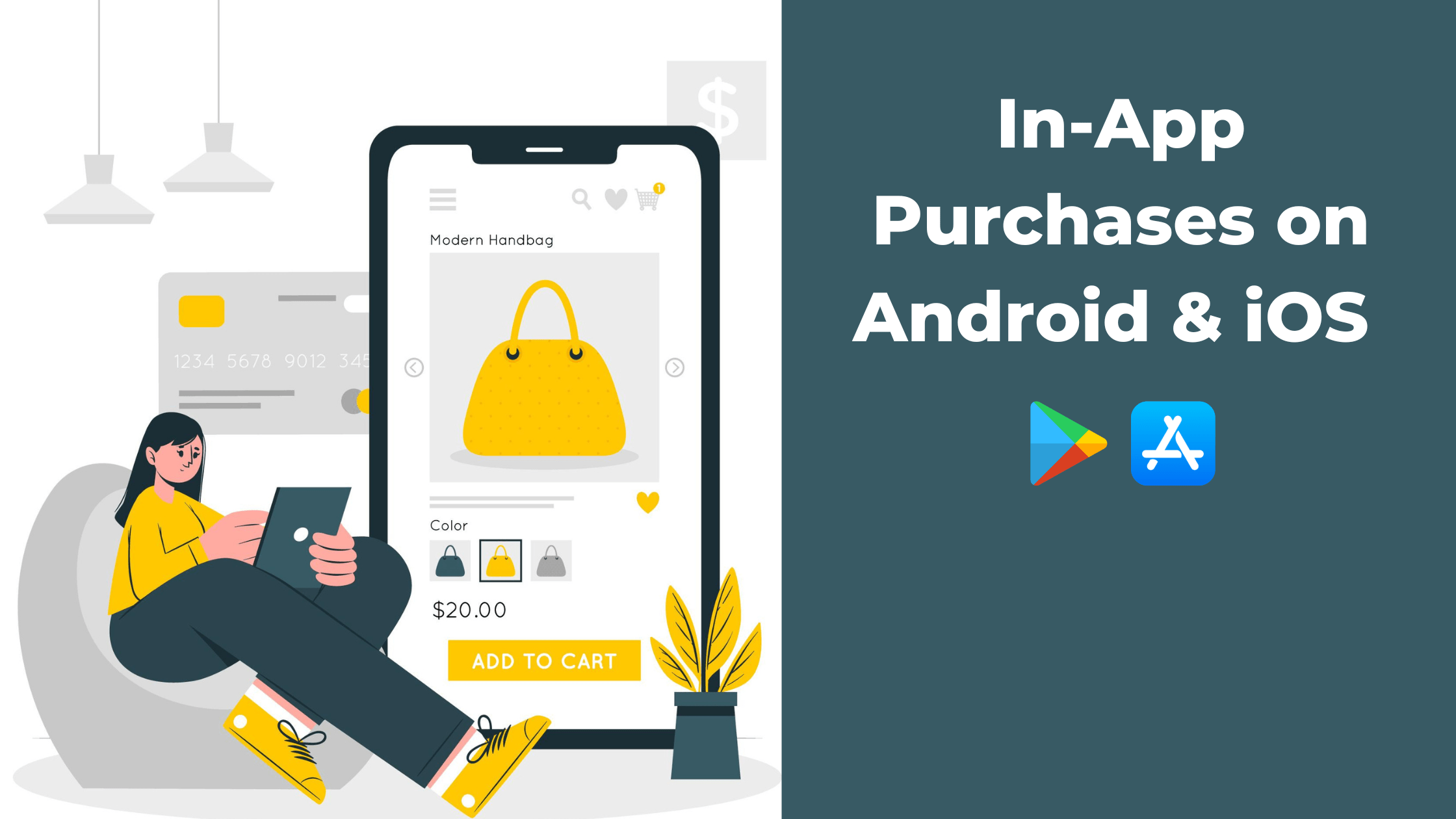In 2020 alone, $218 billion will be downloaded from mobile apps. With each passing year, the number is likely to increase.
There are several revenue generation models in 2022, but in-app purchases stand out the most. Getting a sustainable revenue source from in-app monetization requires some experimentation.
Mobile applications are dominating the market – users spend over 90% of their time using them. Choosing and implementing a revenue monetization model correctly can make your mobile app an excellent source of income. According to app sales statistics, 48.2% of all mobile app earnings come from in-app purchases. In second place is paid app revenue, accounting for 37.8% of the total. There is a good chance that these numbers will continue to grow. In this way, app publishers may achieve record incomes.
In this post, we’ll explore in-app purchases as one of the most effective ways to monetize apps.
What is In-app Purchase(IAP)?
The in-app purchase (IAP) allows you to sell products, content, and additional features and functionalities using an Application Programming Interface (API) that is integrated into the application. In-app purchases can be made directly through Google Play and the App Store. Among all app monetization methods, in-app purchases are the most practical and popular.
Most of these purchases are based on the freemium model. In this model, a free product is released with limited features (the free version offers unchanged options and no time limit), and additional content is charged for (new features, bonuses, and advanced features).
A free version of the product is very useful for users who wish to test out the application and decide if they like it. Users upgrade to the premium version of the app if they like its features and idea.
Types of In-app Purchases
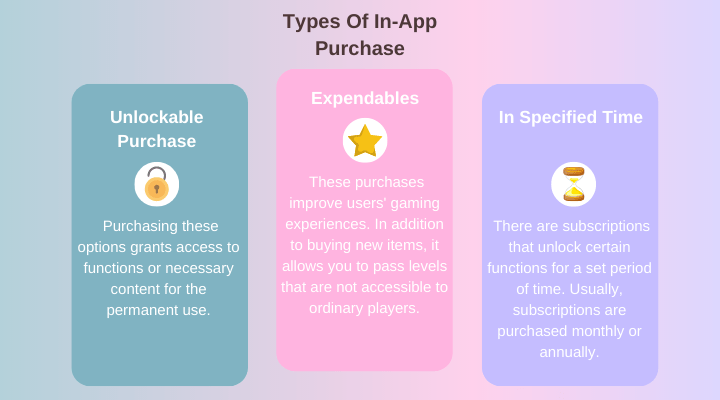
There are three main types of in-app purchases:
1. Non-Consumable Purchases or Unlockable purchases:
These in-app purchases are one-time purchases that have no limit (no expiration). In-app purchases of such non-consumable items allow users to access the premium features of the app. These features are purchased for permanent use, and they allow access to functions or add-on content. Once you buy them once, you don’t need to buy them again (there is no re-purchase required).
For example, features such as disabling ads in the application, add-ons (skins of equipment, avatars, etc.) to games can be unlocked and Additional filters in a photo app.
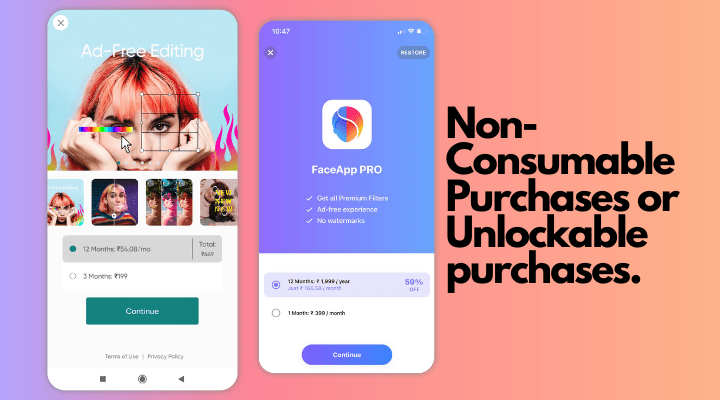
Consumable Purchases or Expendables:
Consumable purchases refer to the features, digital goods, or real products that can be used up and repurchased multiple times.
For instance, in free games, you can buy additional coins that help in the gameplay, allow you to buy new characters or items, and also unlock levels that are inaccessible to ordinary users. Another example is, users can purchase digital items from dating apps to increase the visibility of their profiles, get access to the premium features, content, and so on.
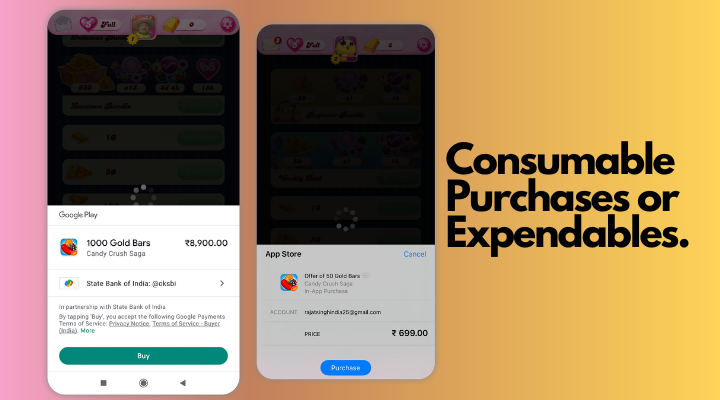
3. Subscriptions:
These unlock certain functions for a specified time. Subscriptions are usually purchased monthly or yearly. However, app developers provide freemium before actually asking for a subscription to help the users understand the app better.
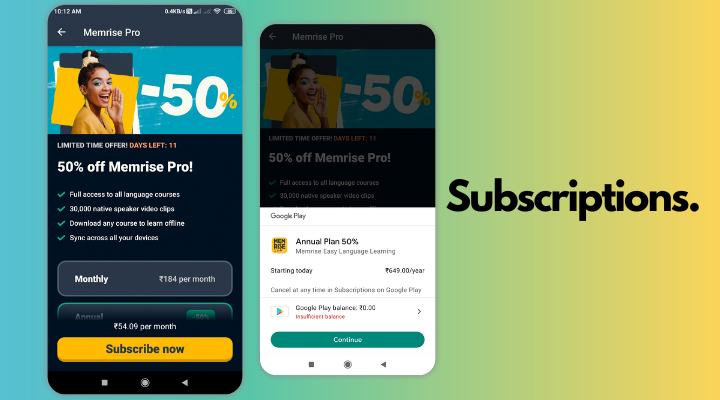
- Non-renewable Subscriptions
These in-app purchases allow the app users to access an app service for a limited period. This subscription is not subject to automated renewal and users must purchase another subscription before the access expires.
- Auto-renewable Subscriptions
These in-app purchases apply to all the latest accessible digital content, premium features, or services of an app. It means users pay a recurring fee until the cancellation of the service. The most common examples would be the media content or libraries. Other examples include educational or SaaS (Software as a Service) services such as cloud storage, graphic design, or productivity.
In-app purchase Google Play vs Appstore: Commission for In-App Purchases (IAP)
| Google Play | AppStore | |
| Cost | One-time fee Google Developer fee $25 + 30% commission on all IAP | Apple Developer fee $99/year + 30% commission on all IAP on total cost paid by the customer |
| Refunds | Refund after review is less than 2 hours | Within 2 weeks (14 days) |
Difference between In-App Purchases (IAP) on Google Play and Appstore

In-app purchase (IAP) on Google Play

It has been speculated that Android will soon become the market’s leading mobile application due to its growing market share. The billing implementation in the Android applications is managed by the Google Play In-App Billing Service.
Google Play manages the financial transactions in the app, so you need a Google Wallet merchant account. You provide digital content and publish it to Google Play. Remember that you cannot publish the same product for multiple Android applications.
Another point to remember is that Google Play is not responsible for content delivery. It means you have to display or showcase the digital content you want to sell on multiple Android applications. For example, if you want to make digital content available on multiple apps with in-app purchases (IAP), you can’t publish the same product for another Android-based app.
With in-app billing, Google Play allows you to manage in-app subscriptions and products on your Android phone. It comes with adaptive and one-at- a- time purchase flow along with a wide range of features. You might not be aware of it, but the billing system of Google Play is robust and allows users to sell digital content and products directly into the Android application effortlessly.
Google Play billing system can be used to sell the following items:
- Consumable or non-consumable products: A consumable item is a product that a user consumes to get content in an application. After the user has used the product, it can be re-purchased. A non-consumable product is bought only once for a permanent benefit.
- Subscriptions provide access to content regularly. The Google Play Console provides flexibility in terms of creating subscription-based products. You can choose from a wide range of options like a free trial, set a subscription price, set add-on period and discount set compensation in the event of a payment failure, and the ability to cancel a subscription or pause it if needed. Once the customer has made an in-app purchase, there is no refund possible via the app store. Customers will need to contact you(the app developer) directly, so duplicate all billing information on your server to prevent any issues.
In-app purchase (IAP) on App Store

On the surface, iOS in-app purchases are not so different from IAP in Android. But in iOS, in-app purchases are embedded with a store kit framework. To deliver an in-app shopping experience on iOS, you are required to create an in-app shopping store and embed it in the app. This store is integrated with App Store using the Store Kit platform. This platform provides secure payment processing, as well as provides a transaction notification function.
There are five types of items that can be purchased in the iOS app.
- Consumables
These items are easy to incorporate in apps; the user can buy them every time they need them. For example, game players can purchase extra coins or extra lives.
- Non-Consumables
They are purchased just once, and the user has access to them from all their devices at all the time.
- Auto-renewable subscription
This subscription is automatically renewed until the users cancel it themselves. You must provide users with clear instructions on how to unsubscribe to avoid complaints.
- Free subscription
The content provided to the users is completely free, and customers can opt out of it if necessary.
- Non-renewable subscription
The subscription has a limited period duration and must be renewed by the user.
Does Apple or Google charge for these payment services?
Both Google and Apple take a cut as a fee for each purchase made on the application marketplace. This cut is in percentage, and it differs according to the purchase being made.
- One-Time Purchase
Both Apple and Google charge an overall 30% fee for all one-time purchases.
- Subscriptions
Both Apple and Google charge a 30% fee for all subscriptions for the first year. After the first year, this fee is reduced to 15%.
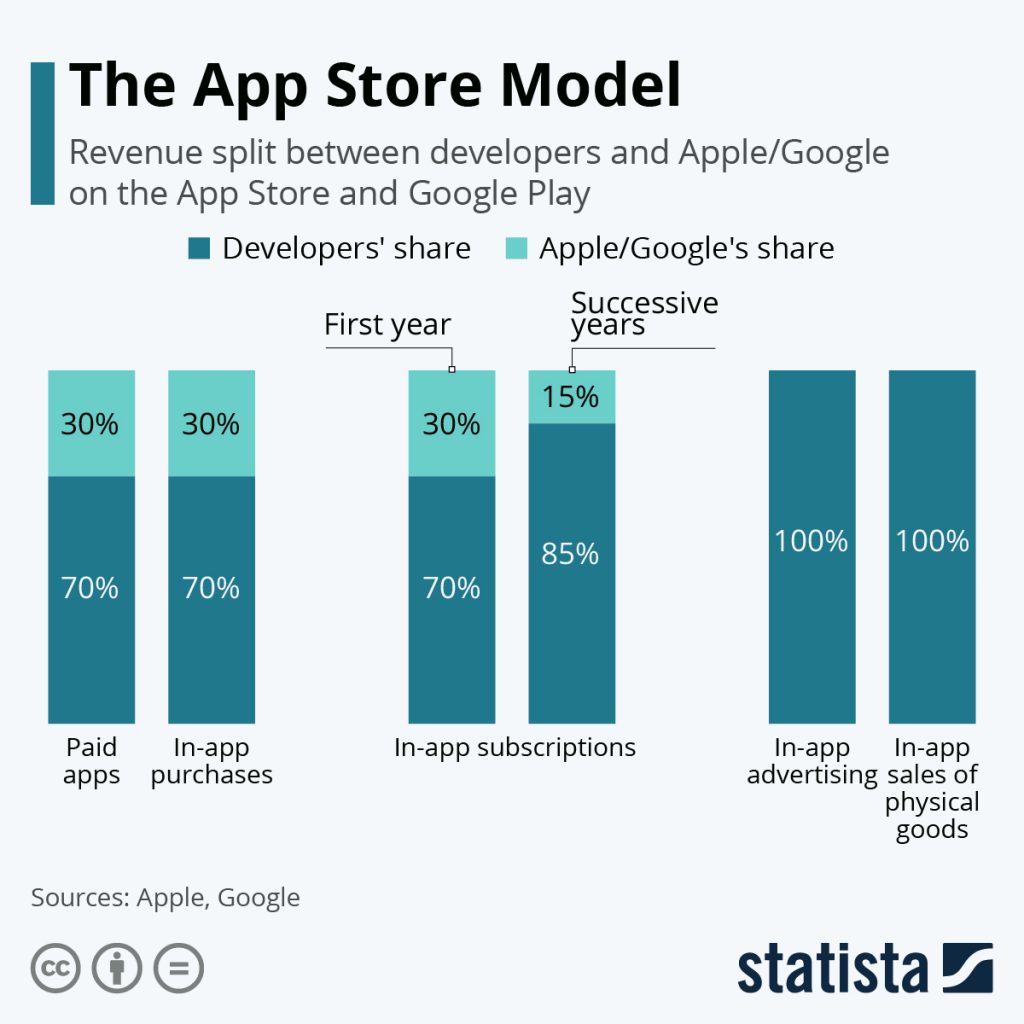
The current issues of in-app purchase
Accidental purchases and Pop-ups
A number of people have experienced unauthorized in-app purchases by children, and Apple refunds customers if purchases were made by children. In order to prevent erratic purchases and ensure greater safety, several strategies have been implemented.
Once the user selects a purchase, a window appears where they can click “OK” or “Settings.” Settings allow users to disable the password request function or set it to never ask for a password for in-app purchases. Moreover, buyers can use the “15-minute window” feature to make purchases within 15 minutes without having to re-enter their password.
For individuals who make multiple digital purchases on a regular basis or for busy individuals who don’t have a lot of time to choose and purchase content, this feature will be very useful.
When it comes to Google, it provides detailed instructions on how to set up a mobile device to require a password every time.
High commission fee of both the Stores
For example, assuming that sales generate $10,000,000, and you spend about $6,000,000 on marketing expenses for servers and labour, the share between Apple and the developer of the revenue generated by the app is as follows.

*Commission = 30% on sales over $1,000,000
Amid increased regulatory scrutiny over how it runs its App Store, now it had reduced the App Store commissions for smaller businesses. Developers making up to $1 million per year will only have to pay a 15% commission on in-app sales, rather of the customary 30% fee, under the revised parameters of the “App Store Small Business Program.”
Conclusion
Increasing internet usage means more in-app purchases in the mobile eCommerce landscape. Over the next few years, in-app purchases are expected to generate billions of dollars in revenue. To achieve these long-term revenue generation goals, your mobile app must have the right platform and content.
Quality and security of mobile apps are hard to beat in the App Store. However, Google Play does not lag behind in any way when it comes to mainframe security. With much lower development costs, Google Play has become more user-friendly.
Furthermore, developers have more freedom in Google Play when it comes to making social and personal choices. Ultimately, it comes down to the target market and user demographics. In order to develop a suitable monetization strategy, you need to consider your preferred business model.
